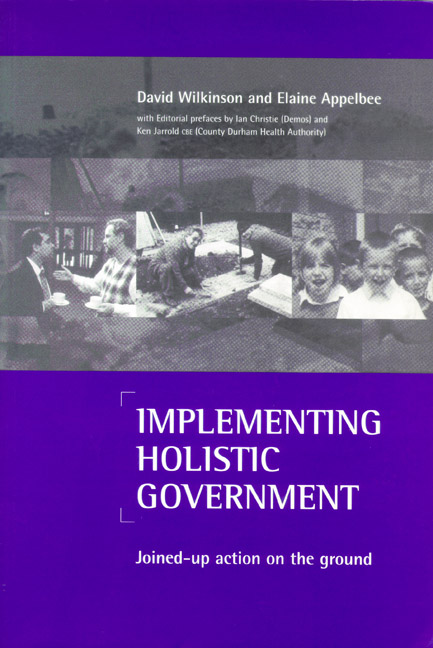Book contents
- Frontmatter
- Contents
- Editorial preface
- Editorial preface
- Acknowledgements
- Summary
- 1 Setting the context
- 2 The functional inheritance and its consequences
- 3 The public service, community interface
- 4 Change that works – sustaining community and quality of life improvement
- 5 Change that works – sustaining organisational and whole system change
- 6 Developing the middle ground: where bottom-up meets top-down (a third way for local governance?)
- 7 Improving sustainable quality of life: the benchmark for Best Value
- 8 Joined-up action on the ground: six key issues that have to be addressed
- 9 Working in the middle ground: recommendations to promote joined-up action on the ground
- References
4 - Change that works – sustaining community and quality of life improvement
Published online by Cambridge University Press: 05 July 2022
- Frontmatter
- Contents
- Editorial preface
- Editorial preface
- Acknowledgements
- Summary
- 1 Setting the context
- 2 The functional inheritance and its consequences
- 3 The public service, community interface
- 4 Change that works – sustaining community and quality of life improvement
- 5 Change that works – sustaining organisational and whole system change
- 6 Developing the middle ground: where bottom-up meets top-down (a third way for local governance?)
- 7 Improving sustainable quality of life: the benchmark for Best Value
- 8 Joined-up action on the ground: six key issues that have to be addressed
- 9 Working in the middle ground: recommendations to promote joined-up action on the ground
- References
Summary
One of the most depressing aspects of the study of urban regeneration is the incidence of wheel reinvention, and the failure properly to absorb the lessons of experience … there have been the 5-volume ESRC study on urban economic development, the 70 papers generated between 1987 and 1993 by the Inner Cities Task Force Initiative, the DoE's Inner Cities Research series; and a substantial research programme in Scotland, commissioned by the Scottish Office, Scottish Enterprise and Scottish Homes. Yet there is little evidence that practitioners or policy makers learn from all this. (Fordham, 1995, p 30)
In the context of what has been written so far, perhaps the failure to learn is hardly surprising. It is this insularity – the ‘not-invented-here’ syndrome – that is at the core of the corporate amnesia of much of local government in particular and service delivery agencies in general. Essentially, the new public service agenda requires systemic understanding and action from organisations whose dominant cultures and mental maps are from a different world. Certainly there are many examples where people have innovated against the grain but this is frequently difficult and sometimes contentious within the organisations themselves. This is all the more paradoxical when such innovation follows apparently stated policy. The rhetoric of change and partnership frequently outruns the reality of experience.
Changing the cultures and structures of public service organisations to meet the new agenda will be a formidable task. To approach this, it is necessary to understand some of the key processes involved in change that works. This will be done here from two linked perspectives. Firstly, from the more external focus of sustainable community change and development and secondly, from an internal focus of organisational transformation. From these understandings it is possible to start on the task of constructing a series of recommendations to establish other levers and frameworks capable of enabling public service delivery bodies to make the cultural leap that in so many cases will be necessary.
Sustainable community building
It is now widely recognised that the weakening of community and social bonds of cohesion is inextricably linked with the problems of poor health, unemployment, social disadvantage and poverty. Further, the rebuilding of this cohesion, or social capital, is the stated aim of many regeneration interventions.
- Type
- Chapter
- Information
- Implementing Holistic GovernmentJoined-Up Action on the Ground, pp. 57 - 66Publisher: Bristol University PressPrint publication year: 1999



